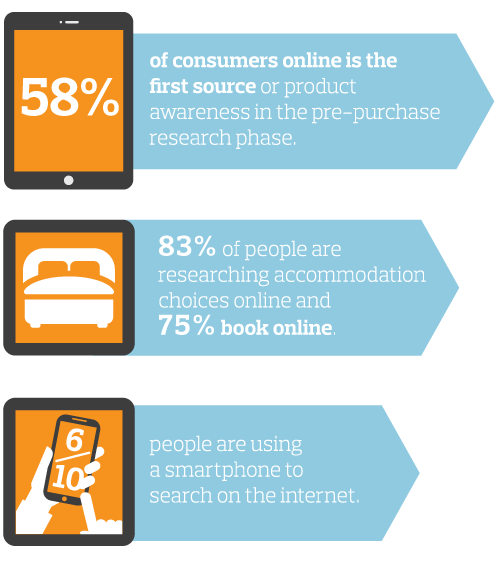When you’re trying to attract visitors to your destination, you’re competing with every other destination. So, the first place to make your destination stand out is with a good visitor information website that works.
Here’s the latest in key requirements, best practice in design and content required and some of the technical stuff you need to know to commission a successful visitor information website.
First some data to set the scene
The latest Australian data from Google shows that –
Key requirements for visitor information websites in 2015.
Visitor information and destination websites cannot just be brochures.
They need to engage users, measure that engagement and build a base of followers and advocates to make future promotional efforts easier.
Best practice in design & content for visitor information websites
Intuitive and attractive design
The design of the website is important. It needs to be:
- easy to navigate
- highly visual
- has the right balance between simplicity and enough information.
Slideshow tours
These give a sense of what it is like to be there. Try incorporating media: photos, videos, or sound to make the destination come to life. This adds to the user’s experience and the likelihood of them sharing the website with family and friends.
Helpful, entertaining and sharable content
Tourism websites need remarkable content to attract visitors and encourage inbound traffic. Viewers can turn into advocates –helping to share, link to and engage with website.
Make bookings easy
Include search functions that make it easy to search for, book and pay for accommodation, events, activities, etc. Alternatively, include links to operator and partner websites where visitors can book directly. Be sure to keep your content about and links to the operator/event/activity up-to-date (events that have passed or operators that are no longer in business are a real turn-off).
Trip Planner
Include useful trip planning tools to build appeal, simplify the planning process and help promote quality partners. Make it easy for users to save their trip plans and share them.
Destination and attraction maps
Maps help to connect visitors to the destination, facilitate planning the trip and wayfinding during the trip. Making maps easy to bookmark, save or access on mobile devices is an added feature that will add to the visitor experience.
Blog
A blog gives you the freedom to create a wider variety of content. Content is key for organic search rankings and Inbound marketing.
News
Have the ability to post news and updates on the website (with it clearly visible on the home page) – so you can share and generate interest in events and specials, etc.
A mobile responsive website
Accessing the visitor information website on a mobile device is hugely important for all stages in the trip – from research to planning to visiting and afterwards.
Social media sharing tools
Make it easy for visitors to post to Facebook, Google, Pinterest, Twitter, etc. This will help to market the destination and website.
Social media following tools
Have clearly visible social following tools to help users connect with the social media you use.
Collect email addresses
Collecting email addresses will let you build a database of subscribers you can use to send news about what’s happening in your destination – this is your chance to do outbound marketing.
Need some inspiration?
Here are the top visitor information websites worldwide.
http://skift.com/2013/12/20/the-20-best-designed-tourism-websites-in-the-world/#1
Need more information?
Contact [email protected] or on +61 (8) 9430 4177 to discuss your project.



